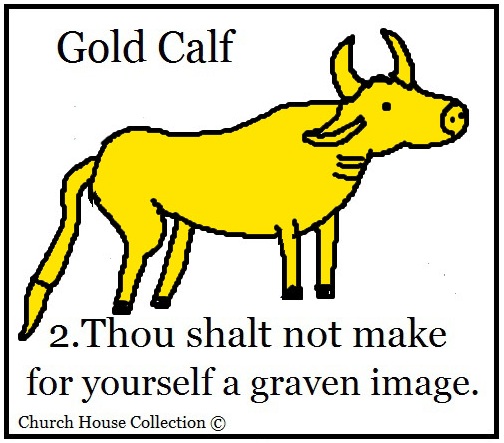

I readily agree that we ought not to worship any image, regardless of what name we give it or what God/god we think it represents.

At any rate, regardless of what it represented, the people then worshipped the image (v. It looks to me like Aaron intended it to represent YHWH, but that the people were not so clear in their intent. Some commentators argue that this image was supposed to represent YHWH, the true God. For instance, we can look at God's displeasure at the Israelites' use of the golden calf in Exodus 32. They also appeal to the ways we see God respond to images throughout Scripture. Now, in all fairness, most arguments against using images in worship and making images of God do not appeal only to the wording of the second commandment. 26:1,31), and spanning the Holy of Holies (1 Kings 6:23ff.) all kinds of things on the doors to the doors sanctuary (1 Kings 6:32,36). 28:33) angels on the Ark of the Covenant (Exod. 52:20) pomegranates on the clothes of the priests (Exod. 25:31ff.) a huge basin resting on the backs of oxen (Jer. For instance, the tabernacle and the temple were filled with images: lampstands that looked like flowering almond trees (Exod. In point of fact, however, Scripture itself commanded and/or approved the making of certain images of created things, even for use in worship. We cannot watch television or movies of any type, or take x-rays, or use an electron microscope. We cannot put pictures of products in advertisements.

We cannot take photographs of our children. The purpose and function of the image is critical to determining the propriety of the image.īut if we interpret the commandment as prohibiting all images regardless of their use, then we can paint nothing in creation. For example, if I were to paint a picture of a flower, my action would not violate this commandment - even though the commandment specifically forbids making any likeness of what is on the earth. They do not specifically prohibit the use of images in the worship God, let alone the making of images for purposes other than worship. 5:8-9).Īs I understand the passages in Exodus and Deuteronomy, they prohibit the making and worshiping of false gods. You shall not worship them or serve them" (Exod. "You shall not make for yourself an idol, or any likeness of what is in heaven above or on the earth beneath or in the water under the earth. This is what the second commandment itself says: On this point, I don't think the Catechism properly represents the teaching of Scripture. That is to say, even if we don't bow down to these images as objects of our worship, it is sinful to make them, or even just to have them in mind. In the context of answer 109, the Larger Catechism indicates that such images are sinful, regardless of how they are used. "The sins forbidden in the second commandment are … the making any representation of God, of all or of any of the three persons, either inwardly in our mind, or outwardly in any kind of image or likeness of any creature whatsoever." In my circles, the most commonly known argument against such images can be found in answer 109 of the Westminster Larger Catechism, which states in part: A great many names might be assembled to demonstrate that this view has enjoyed widespread Reformed support. Many Reformed theologians have been and are of the opinion that the second commandment forbids any visual depictions of Christ, including those found in paintings, sculptures, movies, etc.
ARE PICTURES GRAVEN IMAGES MOVIE
This would preclude, for instance, viewing Mel Gibson's movie The Passion of Christ.ĭo all Reformed people believe this? It does not seem to be consistent with the meaning of that commandment, although perhaps Reformed people view that commandment differently. I've heard Reformed people say that they do not believe in any visual depictions of Christ, since it violates the commandment against graven images. IIIM Magazine Online, Volume 6, Number 6, February 25 to March 2, 2004 Southeastern Baptist Theological Seminary.He Gave Us Scripture: Foundations of Interpretation.Your Kingdom Come: The Doctrine of Eschatology.Kingdom, Covenants & Canon of the Old Testament.Kingdom & Covenant in the New Testament.


 0 kommentar(er)
0 kommentar(er)
